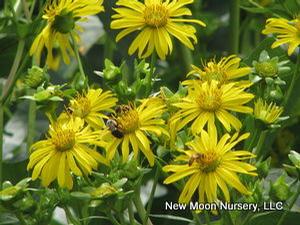New Moon Nurseries
Silphium perfoliatum
Cup plant
Native to North America
FIRST IMPRESSIONS: Silphium perfoliatum is an upright rhizomatous wildflower. This quirky individual has sturdy square stems and large opposite leaves that are joined at the base. The tall stately plants are crowned with yellow daisies in summer for 4-6 weeks. This imposing long-lived perennial thrives in moist sites with sunny or partly sunny exposure.
HABITAT & HARDINESS: Silphium perfoliatum occurs from Quebec to Maine and south to Georgia. Distribution extends west to Ontario and North Dakota and south to Oklahoma and Louisiana.
Habitats include moist Blackland prairies, moist meadows, edges of low woods, fens, seeps, sandy moist floodplains, shores of lakes and rivers, disturbed fence rows, ditches and wet railroad right-of ways.
Plants are hardy from USDA Zones 4-8.
PLANT DESCRIPTION: Silphium perfoliatum is an erect perennial with thick smooth mostly unbranched green stems.
Leaves are broadly lance shaped or heart shaped. Blades average 8” long and 5” across. The leaf bases wrap around the stem and join to form a cup that can actually hold water. The blades have coarse teeth and a rough sandpaper-like surface.
As a result, seed are only produced around the perimeter of the daisy-like flower. The seed are thin achenes surrounded by wings that allow for dispersal by wind.
Plants grow 4-10’ with 4-6’ or greater spread. The root systems consists of a taproot with many shallow rhizomes. Plants expand from the rhizomes to form extensive colonies.
CULTURAL & MAINTENANCE NEEDS: Silphium perfoliatum is easy to grow in sunny sites moist sites. Plants thrive in average, moist or soggy sandy, loamy or clay soils.
This species tolerates some drought after establishment. Plants are taller in wet sites but may lodge or topple if high winds occur when soils are soggy.
LANDSCAPE USES: This tall boy has a striking growth habit that is particularly lovely when plants are arranged in Groupings or Masses. They tend to lean on each other like a chorus of drunken sailors. Plants inject interest into Wildlife Gardens or Meadows and are useful Butterfly Nectar Plants and Host Plants. Silphium perfoliatum has Showy Blooms and is a welcome resident of Cottage Gardens, Rain Gardens, Low Maintenance Plantings, Perennial Borders and Roadsides.
COMPANION & UNDERSTUDY PLANTS: Try pairing Silphium perfoliatum with Aster oblongifolius, Hibiscus moscheutos, Monarda fistulosa or Panicum virgatum.
Helianthus angustifolius is another tall yellow daisy that could be substituted in similar cultural situations.
TRIVIA: Native bees, butterflies, skippers, honeybees, beneficial wasps and flies forage for pollen or nectar. Caterpillars of Silvery Checkerspot, Gorgone Checkerspot, Bordered Patch and Painted Lady Butterflies feed on the foliage. Goldfinches and some other songbirds eat the seed and drink water from the perfoliate leaf cups. The tall robust plants provide good cover for birds and other wildlife. Cattle and other large herbivores browse on the tender young growth.
The specific ephithet “perfoliatum” refers to the perfoliate leaf arrangement where leaf bases join and clasp the stem. The leaves form a small font that functions like a tiny ephemeral pool when rainwater accumulates. Young frogs seek shelter there and tiny insects drown in their attempts to climb the stalks.
Silphium spp. are sometimes called rosin weeds because they produce a resin that smells somewhat like turpentine.
Silphium perfoliatum received a RHS Award of Garden Merit.
Height:
4-10 ftSpread:
4-6 ftUSDA Hardiness Zone:
4-8Bloom Color:
YellowSilphium perfoliatum Characteristics
Attracts Wildlife
- Songbirds
- Pollinators
- Butterflies
Attributes
- Drought Tolerant
- Clay Soil
- Rain Garden
- Bog
- Naturalizing
- East-Coast Native
Exposure
- Full Sun
Flowering Months
- October
- September
- August
Foliage Color
- Green
Growth Rate
- Medium
Season of Interest (Foliage)
- Summer
- Spring
Soil Moisture Preference
- Moist to Wet
Interesting Notes:
For more information on this plant, visit the USDA PLANTS Database: http://plants.usda.gov/java/profile?symbol=SIPE2
